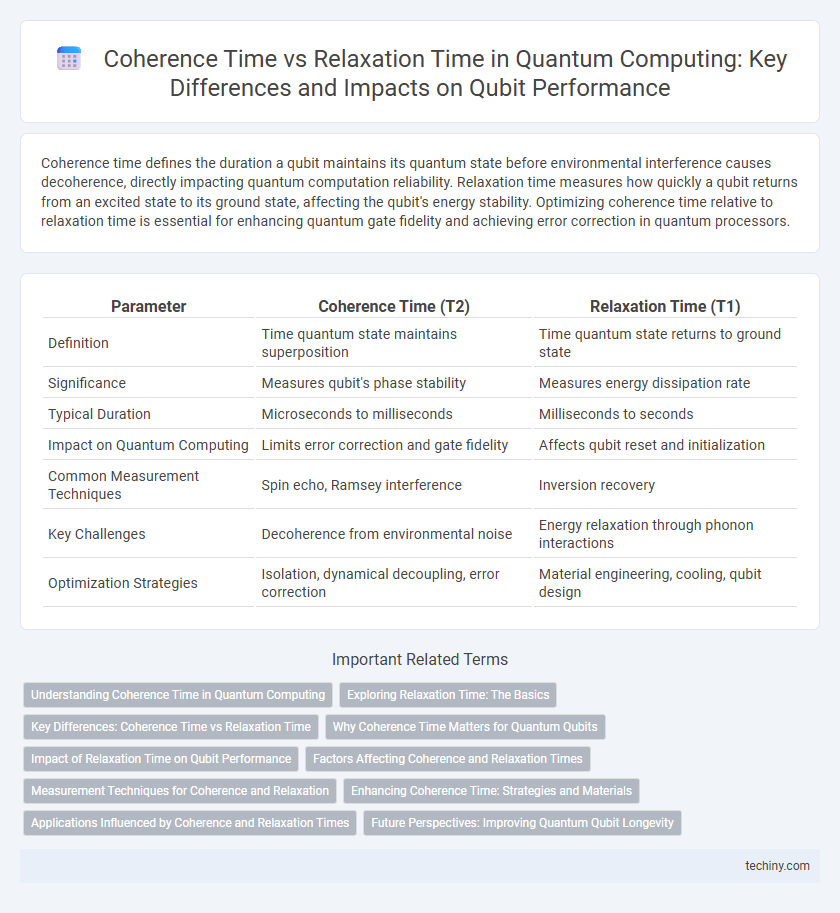Coherence time defines the duration a qubit maintains its quantum state before environmental interference causes decoherence, directly impacting quantum computation reliability. Relaxation time measures how quickly a qubit returns from an excited state to its ground state, affecting the qubit's energy stability. Optimizing coherence time relative to relaxation time is essential for enhancing quantum gate fidelity and achieving error correction in quantum processors.
Table of Comparison
| Parameter | Coherence Time (T2) | Relaxation Time (T1) |
|---|---|---|
| Definition | Time quantum state maintains superposition | Time quantum state returns to ground state |
| Significance | Measures qubit's phase stability | Measures energy dissipation rate |
| Typical Duration | Microseconds to milliseconds | Milliseconds to seconds |
| Impact on Quantum Computing | Limits error correction and gate fidelity | Affects qubit reset and initialization |
| Common Measurement Techniques | Spin echo, Ramsey interference | Inversion recovery |
| Key Challenges | Decoherence from environmental noise | Energy relaxation through phonon interactions |
| Optimization Strategies | Isolation, dynamical decoupling, error correction | Material engineering, cooling, qubit design |
Understanding Coherence Time in Quantum Computing
Coherence time in quantum computing refers to the duration a qubit maintains its quantum state before decoherence corrupts the information due to environmental interactions. This metric is crucial for quantum error correction and algorithm execution, as longer coherence times enable more complex computations. Relaxation time, or T1, measures the interval a qubit takes to return to its ground state, impacting how qubits lose energy and affecting overall device performance.
Exploring Relaxation Time: The Basics
Relaxation time, also known as T1 time, measures how long a quantum bit (qubit) remains in an excited state before decaying to its ground state, directly impacting the qubit's ability to retain information. This parameter differs from coherence time, which quantifies the loss of quantum phase information, as relaxation time specifically relates to energy dissipation processes. Understanding relaxation time is critical for improving qubit stability and designing error correction protocols in quantum computing systems.
Key Differences: Coherence Time vs Relaxation Time
Coherence time measures how long a quantum system maintains superposition without losing phase information, while relaxation time indicates the duration for a qubit to return to its ground state after excitation. Coherence time is critical for quantum error correction and reliable quantum computations, as it defines the window for coherent quantum operations. Relaxation time primarily impacts qubit stability, influencing the overall fidelity and error rates during quantum processing.
Why Coherence Time Matters for Quantum Qubits
Coherence time is critical for quantum qubits as it defines the duration over which qubits maintain their quantum state and enable reliable quantum computation. Longer coherence times allow qubits to perform more complex operations before decoherence, which results from interactions with the environment causing loss of quantum information. Relaxation time, which measures how fast qubits return to a ground state, complements coherence time but does not fully capture the stability needed for sustained quantum entanglement and error correction.
Impact of Relaxation Time on Qubit Performance
Relaxation time (T1) critically influences qubit performance by determining how long a qubit maintains its excited state before decaying to the ground state, directly affecting the fidelity of quantum operations. Short relaxation times reduce the effective coherence window, limiting the number of reliable quantum gate executions and increasing error rates during computation. Enhancing T1 through improved qubit design and materials leads to longer qubit lifetimes, enabling more complex quantum algorithms and higher overall processor reliability.
Factors Affecting Coherence and Relaxation Times
Coherence time in quantum computing is primarily affected by environmental noise, temperature fluctuations, and material impurities that cause decoherence through phase damping processes. Relaxation time, which measures the duration a qubit remains in an excited state before returning to its ground state, is influenced by factors such as spin-lattice interactions, spontaneous emission, and coupling to electromagnetic fields. Optimizing qubit design and employing error correction techniques are crucial for extending both coherence and relaxation times to enhance quantum system stability.
Measurement Techniques for Coherence and Relaxation
Quantum computing relies on precise measurement techniques to evaluate coherence time and relaxation time, critical parameters for qubit performance. Ramsey interferometry and spin echo sequences are commonly employed to measure coherence time by detecting phase decay, while relaxation time is often determined using T1 measurements through inversion recovery experiments. These techniques enable accurate characterization of qubit stability and inform error correction protocols to enhance quantum computations.
Enhancing Coherence Time: Strategies and Materials
Enhancing coherence time in quantum computing relies on minimizing interactions that cause qubit decoherence, such as thermal fluctuations and electromagnetic interference. Employing materials like isotopically purified silicon and diamond-based nitrogen-vacancy centers significantly improves coherence by reducing nuclear spin noise. Advanced strategies include dynamic decoupling techniques and engineered environments that stabilize qubit states, extending coherence time beyond relaxation time limits.
Applications Influenced by Coherence and Relaxation Times
Coherence time and relaxation time critically impact the performance of quantum algorithms, directly affecting error rates and qubit fidelity in quantum processors. Applications such as quantum cryptography and high-precision quantum sensing rely heavily on extended coherence times to maintain quantum states long enough for complex computations and accurate measurements. Optimization of these times enhances the feasibility of scalable quantum simulations and fault-tolerant quantum computing architectures.
Future Perspectives: Improving Quantum Qubit Longevity
Enhancing coherence time and relaxation time remains pivotal for advancing quantum qubit longevity, directly impacting error rates and computational fidelity. Cutting-edge materials research and dynamic decoupling techniques show promise in mitigating decoherence mechanisms and intrinsic relaxation processes. Breakthroughs in quantum error correction protocols and novel qubit architectures are expected to extend operational time scales, enabling scalable quantum computing applications.
coherence time vs relaxation time Infographic

 techiny.com
techiny.com